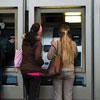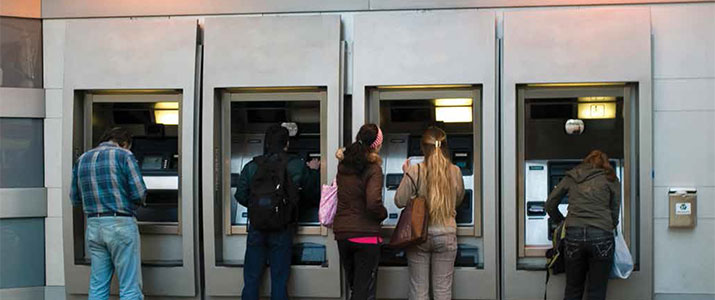
Lighting a New Design
Projecting a safer image within the community
 A large, multinational banking institution with several thousand
branches across the United States was faced with inconsistent exterior
lighting around entrances, ATMs and night depositories,
which presented potential security and safety issues for customers
and employees. This issue was not limited to exterior banking
premises, but also included retail and commercial premises. The ability to ensure
exterior lighting meets and maintains desired objectives was often a result of the
absence of a formalized maintenance and inspection program, lack of staff to focus
on maintenance and the addition of new branches through mergers and acquisitions
that did not fall within existing corporate standards, among other factors.
A large, multinational banking institution with several thousand
branches across the United States was faced with inconsistent exterior
lighting around entrances, ATMs and night depositories,
which presented potential security and safety issues for customers
and employees. This issue was not limited to exterior banking
premises, but also included retail and commercial premises. The ability to ensure
exterior lighting meets and maintains desired objectives was often a result of the
absence of a formalized maintenance and inspection program, lack of staff to focus
on maintenance and the addition of new branches through mergers and acquisitions
that did not fall within existing corporate standards, among other factors.
This situation presented an ideal opportunity for improvement across its various
locations. The institution wanted to take full advantage of the opportunity to
not only enhance safety, but also create a better atmosphere, projecting the best
image possible to the surrounding community. To ultimately achieve its goals, the
bank first sought to standardize its exterior lighting around its facilities, including
ATMs and night depositories at each branch. This would empower them to deliver
consistent safety standards to help protect customers and employees alike, while
also attempting to meet and exceed state regulations, where applicable.
Next, the bank sought to launch a national initiative to inspect every exterior
lighting fixture at every facility and, if necessary, repair and upgrade critical fixtures
over time. This was an ambitious endeavor, encompassing more than 250,000
lighting fixtures nationwide.
To accomplish this monumental effort, the institution needed an outside expert
with the experience and resources to conduct inspections and help make corresponding
recommendations to address any issues. Thus, the bank engaged Dallasbased
GMR, which specializes in facility assessments, security lighting design and
compliance consultations.
This expansive project would require a tremendous amount of upfront planning
and preparation to be a success. A multi-phase strategy was developed through
collaboration with GMR and the bank’s security, real estate and environmental
managers to ensure a smooth execution and positive results. Planning consisted
of an overarching approach to logistics, which mapped out the location and timing
for each site visit, what the inspection would entail and, most importantly, the
ability to capture and log results so they could be effectively shared, reviewed and
addressed.
Phase One
This initial phase consisted of an individual inspection of each banking facility
by GMR’s field technicians to gauge the positioning and effectiveness of lighting
around each building. Each inspection was comprised of an in-person visit to the
grounds to measure light readings and determine the operational status of every
light and fixture.
The key element to this process was
the work being conducted during nighttime
hours. This is a critical step to ascertain
exactly how light appears when
it is in action. Seasonality also had to
be factored in, because lights had to
be evaluated with and without foliage
to determine if they provided adequate
year-round coverage.
Phase Two
After the inspections were concluded,
findings were logged into a centralized
database to analyze deficiencies and
categorize them appropriately, determining
the next steps.
These designations were put into
place to help project overall costs, as
well as conduct capital cost prioritization
to outline the best course of action
to make the necessary maintenance and
repairs efficiently.
Phase Three
With this detailed analysis complete,
GMR worked with the bank’s security
team and property management representatives
to establish a long-term
strategy that factored current risk,
quality of current lighting and overall
site safety. They created a consistent,
repeatable action plan that would institute
an effective lighting design, applied
on a case-by-case basis to each
facility over a designated period, starting
with properties that had the greatest
needs.
As sites were upgraded, this rollout
consisted of replacement and upgrades
of lighting fixtures to ensure that each
branch not only met the banks’ high
internal standards, but also complied
with relevant state guidelines.
Fixtures attached to a building can
prevent light from being projected
properly, thereby creating dark areas
that can create safety issues by providing
areas of concealment. If this was
the case, fixtures were placed on poles
so light could be cast more evenly to
prevent islands of darkness.
Other considerations for repositioning
lighting included the influence of illumination
spillover from other properties.
In many municipalities, it is against
building codes for light to be projected
over property lines. As such, it was important
that the bank kept all of its resources
focused on its own property.
Lighting Sources
Due to performance issues, as well
as maintenance and energy costs, the
types of lights being used came into
question. Traditional metal halide
lights cast a clean white light, but can
degrade substantially over time. These
lights also take time to achieve full
brightness once activated, thus creating
a safety issue for pedestrian traffic
as the lights “cycle up.” Fluorescent
lighting can be yielded ineffective by
extreme hot or cold temperatures, severely
limiting usefulness.
With the shortcomings of existing
lighting, new solutions were explored
to maximize performance, minimize
maintenance and reduce energy costs.
LED has gained ground in recent years
as a legitimate alternative to traditional
lighting sources and was evaluated as an
alternative. LEDs last longer than other
lighting, and most manufacturers offer equipment warrantees of five to 10 years
in the event of a malfunction.
Because this type of lighting was
such a departure from the norm, the
bank chose to proceed with a pilot program
to ensure that a move to LED
would be effective across their entire
network. They needed to ensure that internal
and regulatory standards could
be met and that the costs of installation
and operation would not be exorbitant.
The pilot program proved to be
a success, and should pave the way for a
transition to LED lighting on a broader
scale as facilities are upgraded.
By initiating the process to standardize
and enhance lighting around its
facilities, and putting forth formalized
data collection processes to track, monitor
and compare inspections, the bank
was able to reap a number of benefits.
First and foremost, effective lighting
levels helped support customer and
employee security and safety around
the exterior of facilities. Further, the
updated lighting design and fixtures enable
security cameras to perform better
with enhanced visibility to capture images
and colors accurately.
Consistent lighting design and fixtures
put forth a customer-friendly environment,
creating a warm and friendly
atmosphere to conduct business on a
regular basis. The look and feel of the
lighting at each facility also stood out
in their respective neighborhoods, further
contributing to the attractiveness
of the property, enticing traffic.
Finally, these measures, as well as
the accompanying documentation and
inspections, can also be used to demonstrate
that reasonable steps were taken to
institute safer environments, protecting
customers and employees from harm.
This can then be used to mitigate legal
action if a negative incident takes place.
Ongoing inspections and data collection
make maintenance and upkeep
far more effective. The ability to track
what work was conducted creates a
scheduled framework to ensure that all
lighting fixtures are performing at their
highest level.
This exercise presented a bonus
beyond the enhancement of lighting
design to improve safety and security.
The transition to LED lighting reduced
energy consumption, which benefitted
the bank from a cost and sustainability
perspective. Expense from maintenance
and repair was also lowered, because
LEDs last much longer than conventional
lighting.
LEDs also are an “instant on,” with
no power-up delay and do not degrade
over time. When they are activated,
they reach full lighting capacity and do
not fade as they reach end of life, which
helps make sure lighting is always at
maximum capacity to support security
and safety.
Putting forth the vision to make
sweeping changes on a national scale in
partnership with a reliable, proven consultant,
the bank now enjoys cohesive
lighting design standards backed by formalized
processes to
help keep facilities, customers
and employees
safe and secure.
This article originally appeared in the February 2013 issue of Security Today.